The typical company now runs 130 different SaaS tools. Once upon a time, that stat felt like a flex – proof of digital maturity! These days, it reads more like an admission at Software Addicts Anonymous.
Everyone is happy to have their own tool, but the whole company remains atomized if there’s no glue – SaaS integration best practices (because your apps deserve only the best) – between these bricks. They let your apps know that they are part of the same system.
This roadmap reveals how to integrate your arsenal, kill off the mindless tasks hemorrhaging your time, and build a software suite that acts like a single brain instead of a dysfunctional parliament. Done being the switchboard operator for your own tools? Let’s roll.
Table of Contents
- What is SaaS Integration?
- Why SaaS Integration is a Business-Critical Priority
- Common SaaS Integration Challenges and How to Overcome Them
- SaaS Integration Best Practices: A Step-by-Step Framework
- Popular SaaS Integration Use Cases and Examples
- The Future of SaaS Integration: Trends to Watch
- Conclusion
What is SaaS Integration?
SaaS integration connects cloud-based apps so they can share information and run processes automatically rather than waiting for someone to move data around manually. When all your systems access the same current information, operations speed up and teams collaborate without constantly double-checking whose data is correct.
The technical side runs on APIs – go-betweens that let apps swap information using standard formats like JSON or XML while keeping everything secure. When something happens in one app, a trigger notices and sets off a chain reaction. It could be real-time, or it could be scheduled for batches.
SaaS is taking over the world by storm. By 2032, the SaaS market is projected to soar past $1.1 trillion, growing about 20% every year. What does this mean? Those who tried to avoid or minimize the number of such apps in their ecosystem will likely give up and embrace the innovation, which means they will need a reliable integration method and tools.
There are three types of SaaS integration:
- Native integrations
Built directly by the companies behind the apps, these integrations are custom-fit for their specific platforms.
- Third-party integrations
Plug in a connector someone else built, set up your field mappings, and watch your apps exchange information.
However, the simplicity of this method doesn’t cancel the fact that it can be advanced, too. For example, Skyvia, an iPaaS platform, simplifies integrations by offering a gallery of 200+ ready-to-use connectors and different scenarios:
- For basic needs – Import, Export, Replication, Synchronization
- And advanced ones – Data Flow and Control Flow, where integrations can happen between multiple sources at once.
All of that allows users to organize a pipeline with branching that will still be straightforward.
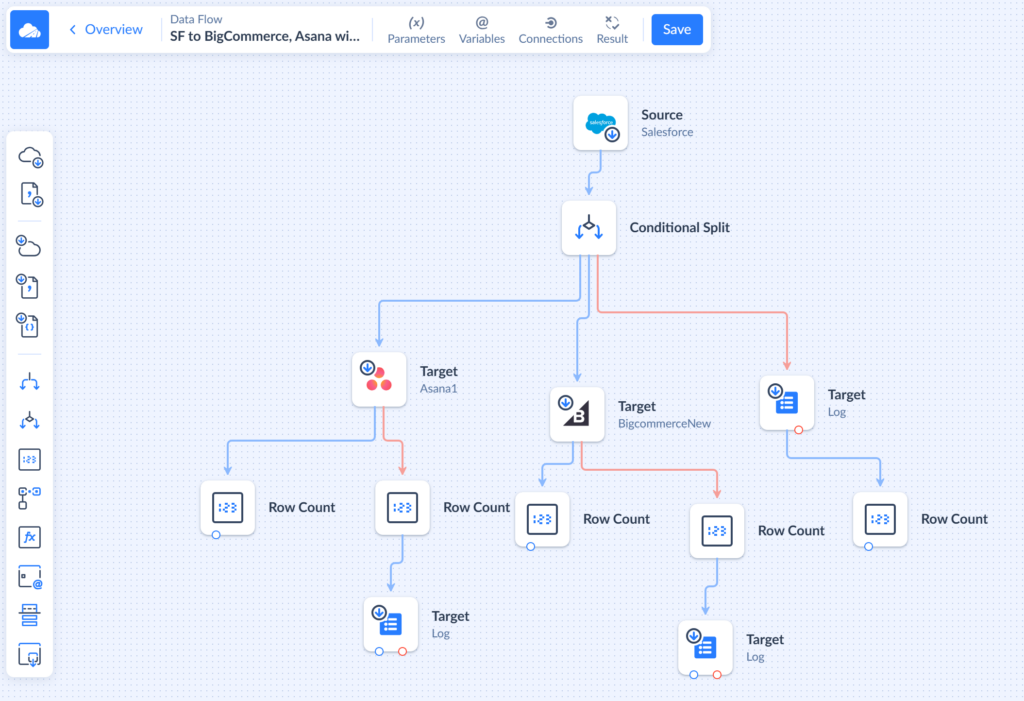
- Unified APIs
Instead of connecting each app individually, one API links to multiple apps in the same space (several payment gateways or various project management tools) through one endpoint.
| Feature / Aspect | Native Integrations | Third-Party Integrations (iPaaS) | Unified APIs |
|---|---|---|---|
| Customization | Highly customizable | Highly customizable | Limited customization |
| Time to Deploy | Longer development cycles, potentially months | Faster deployment, from days to weeks | Fastest deployment, often just configuring endpoints * |
| Maintenance | Higher overhead, requires continuous updates and fixes | Vendor-managed updates, less maintenance needed | Platform managed updates, minimal maintenance required |
| Scalability | Can be limited by internal resources and architecture | High scalability leveraging cloud infrastructure | Highly scalable, designed for broad integration scenarios |
| Ease of Use | Requires significant developer skills and expertise | User-friendly interfaces, suitable for business users | Simple API consumption for developers |
| Cost | High initial and ongoing development costs | Subscription-based pricing, usually lower than native | Subscription or usage-based, cost-effective for multiple integrations |
| Best Use Case | When deep, complex, proprietary integrations are needed | Rapid integration across many SaaS apps with moderate complexity | Fast, scalable, cross-category integration with minimal development effort |
* How quickly API integrations go live comes down to this: API complexity, documentation quality, experience, how ambitious your project is, how fast your testing can reveal hidden issues, and communication responsiveness.
Why SaaS Integration is a Business-Critical Priority
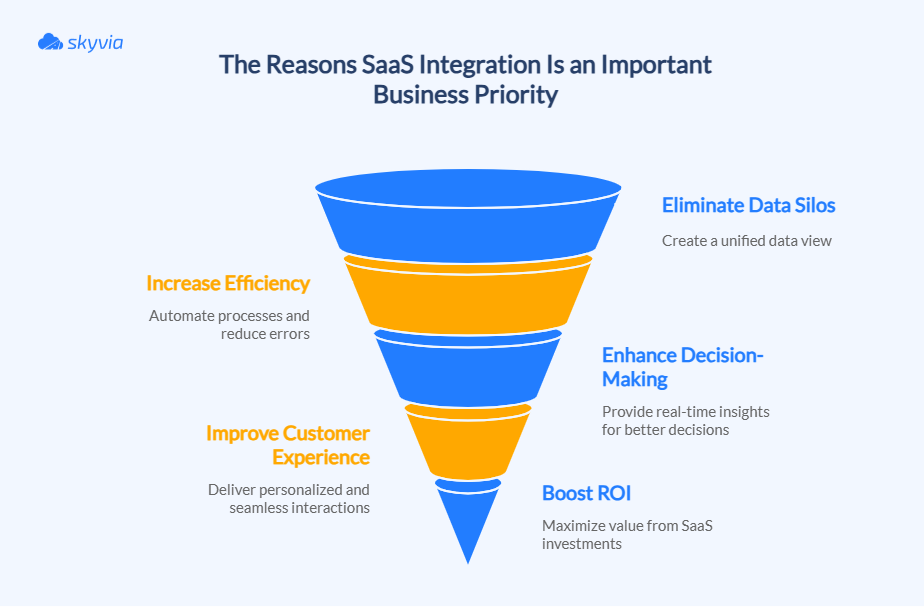
Every team’s got its safe haven – marketing lives in HubSpot, finance won’t pry themselves from QuickBooks, support’s chained to Zendesk by choice.
Let’s take a moment of silence for the data that must move in circles between all those directions, and especially people stuck being the human API, manually forcing output into submission. SaaS integration can tie your tech stack together, and, as a result, everyone is happy, or at least much happier.
Let’s see what you can get once you set foot into this new, brave land:
- Eliminate Data Silos
SaaS integration smashes the walls caging your data in separate corners. By linking infrastructure, syncing up how teams measure things, and automating information handoffs, it builds one trustworthy reference point.
- Increase Efficiency and Productivity
The rule of thumb – if something is manual, it is a momentum assassin in disguise. Wiring your SaaS tools together automates the soul-crushing bits, slashes error rates, and lets your team hunt for bigger games. Real-time updates mean inventory, orders, or tickets refresh themselves instantly, so nobody’s marooned in reconciliation hell or rehashing the same work.
What falls out: smoother operations that clip along faster, stronger performance metrics, and teams that finally have the bandwidth to think three steps ahead.
- Enhance Decision-Making
Decisions built on stale intel or half the story are basically educated guesses at best. Integration takes data from multiple apps and syncs it all up, giving decision-makers a coherent, live-wire view of operations. Everyone sees identical scorecards, KPIs lock into formation, and leadership can commit to bold, information-backed moves.
- Improve Customer Experience
You can’t deliver smooth customer experiences when your systems are basically strangers to each other. Integration bridges that gap. Now your teams operate with full visibility; they know the customer’s journey, preferences, and pain points, all of it.
- Engagement happens when it should.
- Personalization works because you’re not guessing.
- Responses land accurately because everyone’s working from the same script.
- The “let me check on that” delays evaporate.
Customers notice, they stay longer, word-of-mouth works like never before, and the business math starts looking beautiful – people stick around long enough that LTV goes up, while referrals do your marketing so CAC drops, and you can scale without bleeding money on acquisition.
- Boost ROI on SaaS Spend
Spending money on different SaaS platforms only counts if you’re getting every ounce of value. Integration stops your tools from canceling each other out: redundant data gets wiped, workflows get streamlined, and teams can truly harness what’s been purchased. The data automation and consolidation rescue time, slice costs, and back expansion without grinding against ceilings.
Common SaaS Integration Challenges and How to Overcome Them
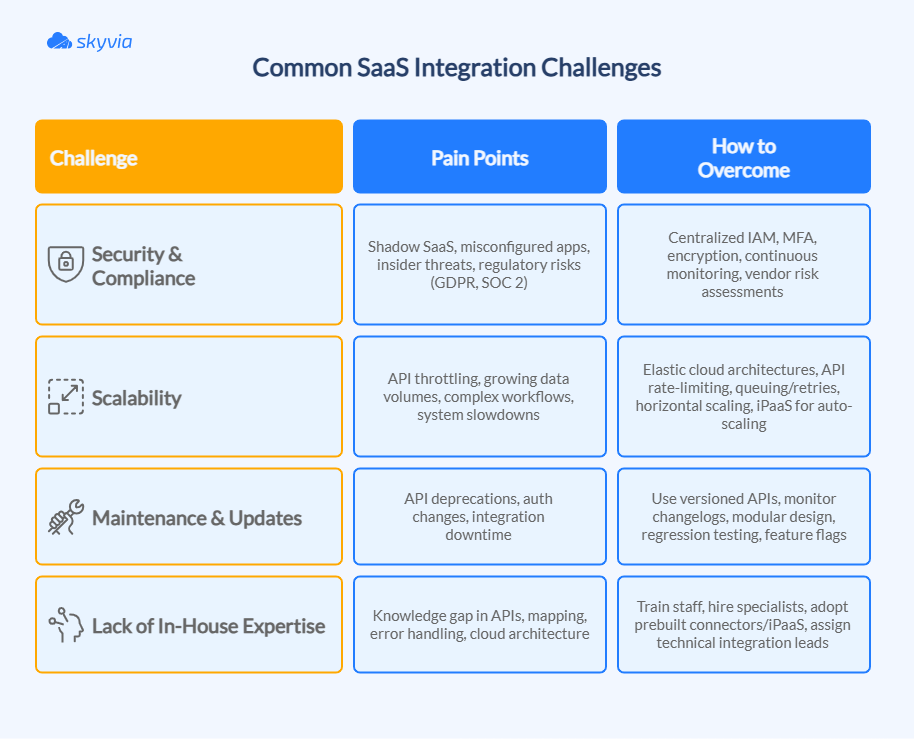
Security and Compliance
SaaS integration opens doors, but also windows for shadow SaaS, misconfigured apps, and rogue insider access. Without proper controls, your confidential records can sleepwalk into GDPR violations or SOC 2 failures.
Centralized IAM and MFA are the answers to this. However, there’s much more you can do to protect the integration better than the Louvre Museum protects Mona Lisa these days:
- Encrypt data whether it’s on the move or sitting in storage.
- Monitor relentlessly.
- Background-check your vendors like you’re entrusting your house keys to them because you do.
Scalability
Scale is the promised land where most integrations go to die slowly. What can handle 100 users might (and most likely will) break once it meets 10,000. APIs start to slam the brakes on your requests, and workflows get so complex that they lose balance.
Reading about challenges and how to overcome them, people dream of some grand solution where you click one button and everything works perfectly.
Maybe someday we will get this button, but now everyone dealing with SaaS integration needs a smart architecture from the start that slashes the chance of total pandemonium. Here are a few quick tips that will help you prepare to enter the point of grandiosity without fear:
- Use cloud-native designs that adapt on the fly.
- Build in queuing and retry mechanisms so failures don’t domino.
- Prepare for horizontal scaling, where you add capacity sideways.
- Use iPaaS platforms that automatically expand and contract with your needs.
Maintenance and Updates
SaaS vendors love updates, but your integrations are not so keen on them. A deprecated API or new auth method can suddenly halt data flows. What can you do when something doesn’t depend on you even a bit?
Stay ahead with versioned APIs, changelog subscriptions, modular integration design, regression testing, monitoring pipelines, and feature flags that let you pause broken pieces until you fix them.
Lack of In-House Expertise
Integrating SaaS apps isn’t some wizard trick you can just wave through (but a bit of wizardry is still possible).
There are APIs to wire up, mappings to create, errors to trap, security to configure, and architecture to design. Plenty of teams get stuck spinning their wheels here. How do you get past it?
- With iPaaS platforms, you can train your existing people first. For example, Skyvia offers no-code visual wizards and numerous pre-built connectors where users can create pipelines with little to no SQL knowledge. The wheel was invented and polished a long time ago for maximum comfort.
- When that’s not enough, hire specialists or contract them temporarily.
- Then assign clear ownership to someone technical who also grasps business priorities.
The right person at the helm and a reliable integration platform in the middle, and suddenly, what felt impossible becomes manageable.
SaaS Integration Best Practices: A Step-by-Step Framework
As with any other serious task, connecting SaaS tools needs a plan. Solid, think-through, strategic, detailed, systematic… a lot of adjectives can be used here.
Let’s cover straightforward approaches that get integration working, minus the usual dramas we explained above. However, if some SaaS integration challenges do happen to you, you already know what to do.
1. Start with a Clear Strategy
Understand your target before building anything:
- What are your actual business goals?
- Which workflows genuinely need syncing?
- Who requires which data access?
Researching each app’s API capabilities, data formats, and weird behaviors upfront stops you from running into problems later. Also, it will help to identify integrations that bring little or no value, which slowly brings us to the next step.
2. Prioritize Integrations
Not every integration opportunity is golden. Most just fill space. So, focus on those that will have maximum impact – critical workflows, high-ROI processes, and features everyone needs. Then the priorities are clear, start to launch them gradually. Otherwise, prepare to be drawn into complexity instead of managing it.
3. Choose the Right Tools and Technology
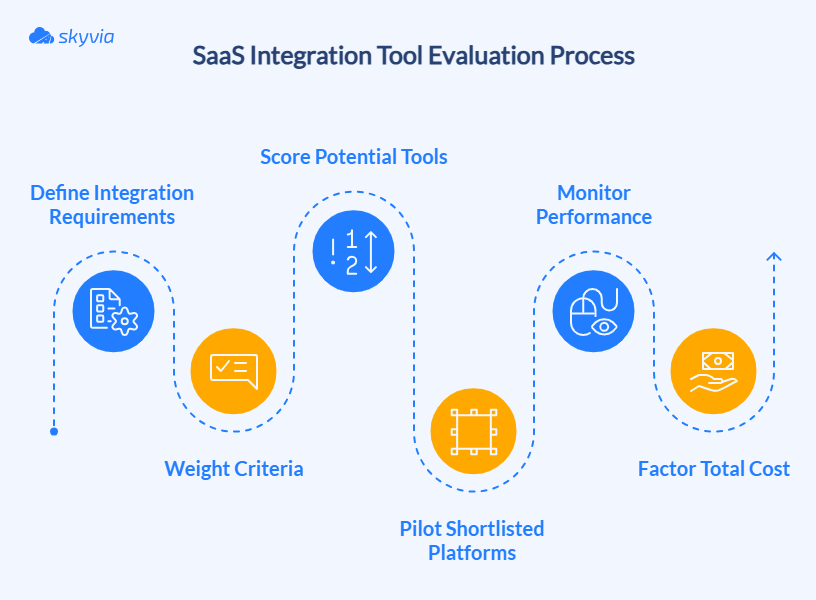
Choosing the best SaaS integration platform is a weighty move. Consider what you’re actually dealing with – company size, security standards, team capabilities.
- iPaaS makes sense for business users, SMBs, and everyone who would like to avoid tedious technical debt, brittle point-to-point connections, and hiring specialized developers just to keep data flowing between apps.
- Embedded iPaaS works when integration is part of your product. Unified APIs cut through complexity.
- Custom code gives you flexibility.
What you can’t compromise on: connectors built and maintained by someone else, automation that handles itself, and monitoring strong enough that data breaches don’t keep you up at night.
4. Plan for Security and Compliance
Let’s make security foundational again. The nuclear reactor core you build everything around. Here are a few concepts to think about (spoiler: data needs them more than it might seem from a first glance):
- MFA stops credential theft from becoming breaches.
- Encryption protects data in motion and at rest.
- Monitor continuously for suspicious patterns.
Your compliance obligations – GDPR, CCPA, SOC 2, HIPAA – demand attention, and automation can handle enforcement. Compliance isn’t red tape. It’s what saves you when incidents happen. So, when choosing an iPaaS tool, check how they treat security.
5. Document Everything
Document your workflows, data mappings, API endpoints, and authentication approaches. Every single one. You’re building a map for whoever comes next, which could be you in six months after your brain has dumped all this information.
Keep updating it. Stale documentation is worse than no documentation because at least nothing is honest about being useless.
6. Test and Monitor Continuously
Before going live, test, test, and test until you can’t stand it anymore.
- Unit tests catch small bugs.
- Integration checks reveal whether your systems actually cooperate or just pretend to.
- Performance runs show what collapses when traffic hits.
- API validations confirm elements talk to each other properly, not just in theory.
It’s always good practice to stay a little paranoid after launch because of possible sync errors, performance drops, weird data swerves, and log messes, etc. Depending on your SaaS integration method and the tool you choose for the task, you can count on alerts to tell you it’s happening.
7. Iterate and Optimize
Your integration never gets to retirement. We hope we didn’t disappoint you.
- Collect feedback from the people who use your systems; they know where it hurts.
- Metrics don’t lie (well, most of the time), so monitor them.
- Adjust workflows when they’re causing friction instead of reducing it.
- Add new integrations in manageable doses, cut loose the ones providing zero value, and keep your SaaS environment lean.
Continuous improvement is what separates integration as liability from integration as leverage.
Popular SaaS Integration Use Cases and Examples
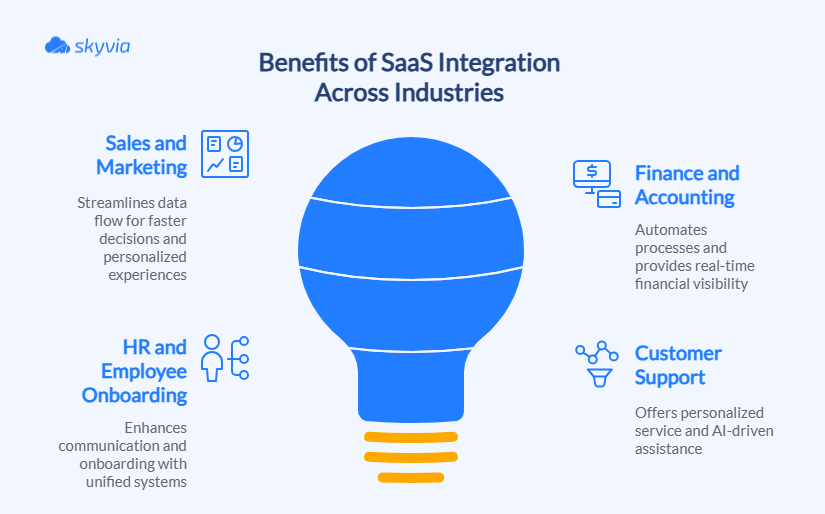
When you see other teams succeeding with SaaS integration, suddenly it doesn’t feel like such a risky move, or at least you see that the risk is justified. Also, tangible wins from real companies tend to be the most useful teaching tool.
Take a look at what businesses in various industries have managed to pull off to start breathing a little bit easier.
Sales and Marketing
An e-commerce company worked with Salesforce, HubSpot, and a collection of payment tools (QuickBooks, PayPal, Stripe), and the data situation was a mess:
- Sales couldn’t locate leads that definitely existed somewhere in the stack.
- Marketing sent campaigns that inexplicably left people out.
- Customer service kept giving outdated information because records weren’t synchronized.
- Payment issues lingered because tracking them meant detective work across multiple logins.
- Billing contacts? They’d vanish the second they needed to transfer from one system to another.
The fix was Skyvia. They used it to dump all the customer and billing data into Salesforce, where everyone could actually find it. Once everything was connected, the teams across the organization noticed the difference first, then their customers did.
Finance and Accounting
NISO does CFO work for companies in the merchant cash advance world, which had their data live in two places – MySQL and QuickBooks Online. Getting it together meant exporting to Excel manually, then importing into QuickBooks manually. It took forever, and there was no way to automate the process because every step required someone to click buttons.
The company started using Skyvia to connect their MySQL databases straight to QuickBooks Online and said Goodbye to custom scripts and repetitive manual work. The platform extracted data, transformed it however they needed, and loaded it automatically.
As a result, NISO simplified the backend machinery of financial workflows, reduced manual effort, and accelerated project delivery. The company gained centralized visibility into client finances and scaled operations confidently without worrying about slow, error-prone manual processes.
HR and Employee Onboarding
The Zammad HR team was having a rough time managing growing new employee information in one place, system access requests in another, and onboarding tasks somewhere else entirely. They needed a way to get personnel data talking to IT workflows without all the manual garbage.
Skyvia established the link between Zammad and HR platforms like Greenhouse.
- One-way and bi-directional automation kept employee information, roles, permissions, and tickets synchronized accurately between HR and IT environments.
- Triggers, scheduled operations, and API communications aligned onboarding procedures, account generation, and access management.
- Each phase – HR modifying candidate data, IT deploying accounts, tickets reaching resolution – became part of one seamless, connected operation.
Departmental walls lowered as collaboration and visibility improved, onboarding happened faster, and employee morale got a boost from receiving tool access right on schedule.
Customer Support
Simply Contact provides outsourcing services for clients in the fintech, retail, and logistics industries, where each client uses different systems. They needed to consolidate these communication pathways, improve how data gets reported, and sustain service standards when traffic climbed during peak windows without everything falling apart.
Zendesk became the gravitational center. Everything flowed into this one platform, which cleaned up how agents worked and improved how quickly they could respond to incoming requests. Skyvia helped to create almost real-time reporting on agent efficiency, customer satisfaction trends, and how workload is distributed across the team.
Results came in two flavors: faster operations and better visibility.
- Data moved through the system 20% quicker.
- Productivity rose by 15%.
- The company’s spending on operations dropped by 10%.
- Customers experienced quicker responses and steadier service quality, which bumped satisfaction ratings up more than 3% across the year.
The Future of SaaS Integration: Trends to Watch
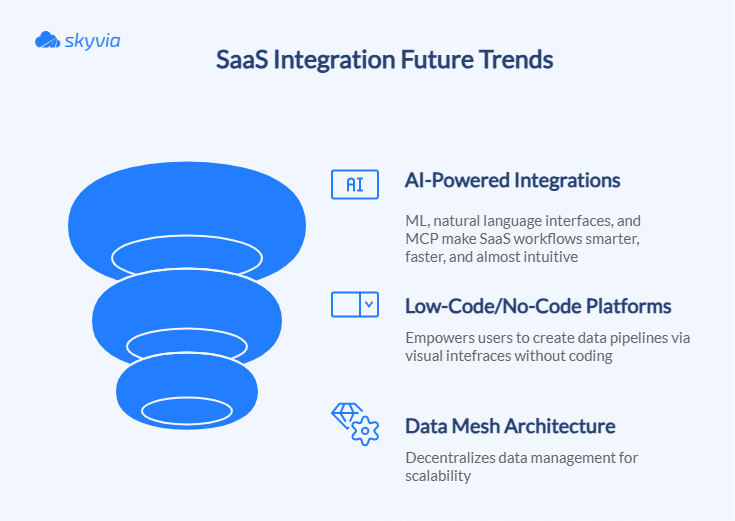
SaaS integration keeps morphing before anyone has figured out the latest version. The future isn’t about linking software anymore; that ship has sailed. Now it’s about intelligence living inside your integrations, business people creating connections without months of studying data science, and throwing out the old script on who controls data and where it actually sits.
Trying to predict where this goes is an ungrateful task, but here’s what you can be sure of in the nearest bright future.
AI-Powered Integration
AI integration can be that friend who finishes your sentences. Teams operating with limited resources suddenly gain capacity that rivals much larger organizations.
- Machine learning reviews accumulated data, surfaces meaningful patterns, and projects likely scenarios, removing manual effort from routine decisions.
- Natural language interfaces and voice controls can launch workflows that cross multiple platforms.
- With MCP (Model Context Protocol), integrations no longer need custom wiring for every connection. Instead, MCP standardizes context-aware data sharing, allowing applications and AI agents to work together smoothly and intelligently. Experts are calling it the “REST API moment” for AI-enabled SaaS – post-2025, expect MCP to make integrations faster, smarter, and surprisingly elegant.
Your integrations start adjusting to actual usage and delivering results that feel almost intuitive.
Low-Code/No-Code Platforms
Low-code/no-code platforms open up SaaS integration to people who don’t write code for a living. Visual interfaces replace programming – users drag components, drop connectors, and watch systems link together.
- The technical complexity gets handled behind the scenes.
- Productivity climbs because routine work like cost projections, alerts, and compliance checks runs automatically.
- Fast deployment matters for DataOps and MLOps teams, and these tools deliver through reusable modules, version tracking, and auto-generated documentation.
When business users can build alongside developers, bottlenecks disappear and SaaS adoption accelerates.
Data Mesh Architecture
Data mesh solves a problem most enterprises hit eventually: your data lives in too many places for one team to manage it all. So instead of centralizing control, you push ownership out to the people who actually understand each domain.
They connect and share through standard APIs and contracts. It’s the United States of Data, where each has its own governor, where everything gets the proper amount of attention, finally.
- Real-time integration works across whatever mishmash of systems you’re running – cloud services, analytics tools, legacy platforms holding on for dear life.
- Governance stays tight because you’re enforcing rules right at the source. For companies running SaaS alongside older infrastructure, this flexibility is huge.
Conclusion
The main task of SaaS integration best practices isn’t to lower the number of tools a team uses, but to turn them into a well-organized army that will stand strong against different challenges. It can create a single powerhouse of efficiency and insight, whether you’re in HR, finance, marketing, sales, etc.
Integration done right doesn’t feel like a burden. It is invisible, reliable, and powerful. It can be summarized in four steps:
Get the strategy → choose tools that know what scalability is → enjoy your operations accelerate while errors evaporate → maintain without challenges.
The outcome is impressive – instead of watching your team waste hours bridging gaps between systems that should’ve been connected years ago, you’re shipping faster than competitors still trapped in integration purgatory. You can scale without the growing pains and turn your tech stack into an unfair advantage.
Skyvia specializes in making that bridge-building obsolete. Visual pipelines, bulletproof security, integrations that deploy in days instead of months. If you’re done being the middleware in your own tech stack, we should talk.
F.A.Q. for SaaS Integration Best Practices
What is a common example of SaaS integration?
Connecting your CRM (like Salesforce) with marketing tools (e.g., HubSpot) and payment processors (e.g., Stripe, PayPal). When a customer makes a purchase, their data automatically updates across all systems—no manual entry, no outdated records, no confusion.
How should a business begin a SaaS integration project?
Start by asking what hurts most. Which workflows eat time? Where does data get stuck? Tackle those first. Map your requirements, pick tools your team can handle, treat security like it matters from day one, then deploy in waves. Better to go slow than to go sideways.
What are the biggest challenges of SaaS integration?
Security vulnerabilities lurk everywhere. Systems buckle under growth. Vendors push updates that snap your connections. Teams lack the technical muscle to build it themselves. The right iPaaS platform and some upfront planning eliminate most of this chaos before it has a chance to metastasize.
What is the difference between native integrations and iPaaS?
Native integrations are built by the vendor, work great for their specific apps, but have a limited scope. iPaaS connects hundreds of tools through one platform, deploys in days, not months, needs less code, and handles maintenance for you.


